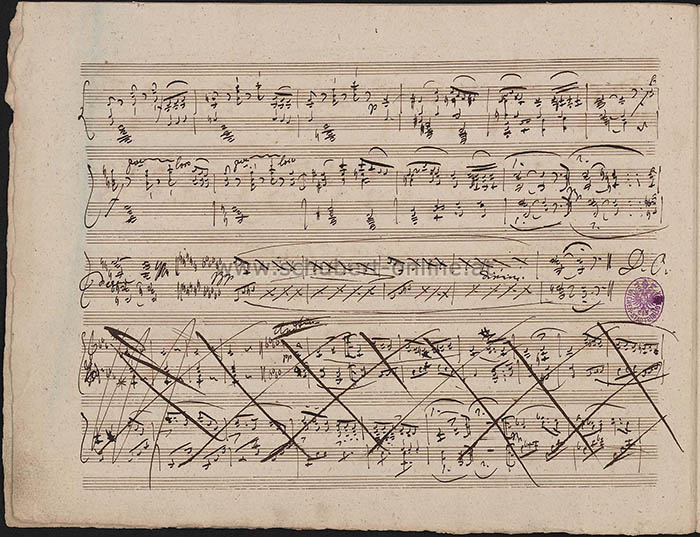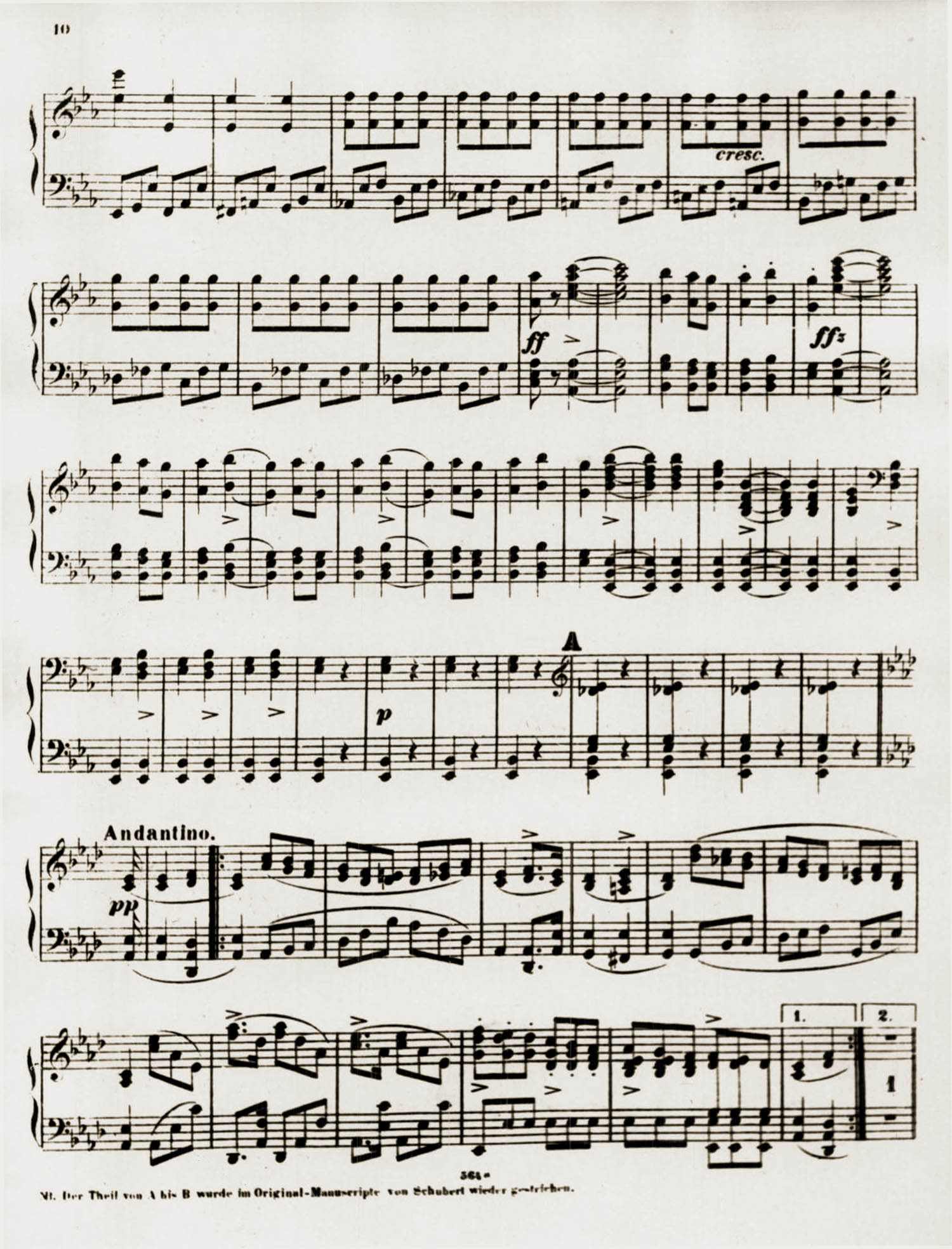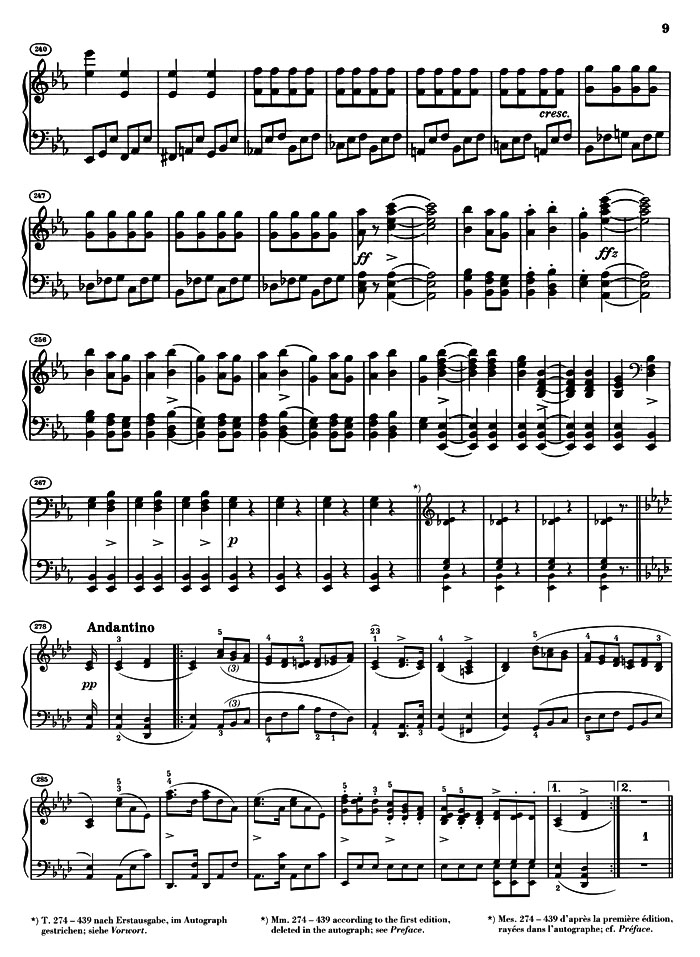Schubert did not live to see the publication of his three impromptus composed in May 1828. They were not printed until 40 years later (!), and it was no less a person than Johannes Brahms who edited these piano pieces beloved by pianists and audiences down to the present day.
There is a problem in the first piece in e-flat minor. And, to my mind, anyone who practices and performs the piece should here come to a personal decision based on the facts. This concerns the ‘C part’ of the rondo-like piece, A – B – A – C – A. Only a few are aware of the fact or take it seriously that in his autograph Schubert unmistakeably crossed out this ‘C part’, thus cancelling it:

Fig. 1: D 946, autograph, p. 4. Vienna, Wienbibliothek im Rathaus, shelfmark MH 143 (visit library website)
We can indeed speculate as to the reasons for this autograph deletion: Was it on formal grounds? Hardly likely, because just such a rondo form is known through many other Schubert pieces. Did Schubert perhaps feel the piece was too long, which is why he crossed out around at least 165 measures (not counting the repeats)? That could have been a reason since both of the other piano pieces of D 946 are only about half as long. Or, did he possibly consider that on musical grounds it was compositionally too slight? Here I personally would quietly nod in the affirmative: The C part in A-flat major seems too innocuous to me, and it does not in any way counterbalance the stirring e-flat minor (which the B part did indeed do lyrically).
But the problem is that Johannes Brahms, editor of the first edition, reversed Schubert’s cancellation and had all the notes reprinted. He, who of all people was so scrupulous, who knew the struggle of a composer for the optimal solution, he ignored Schubert’s express wishes! Why oh why? Again, we can only speculate concerning this… at any rate, Brahms identified the original deletion by adding a footnote:

Fig. 2: D 946, posthumous first edition, J. Rieter-Biedermann, Leipzig/Winterthur 1868
This, to date, has not kept all subsequent printed editions from repeatedly reprinting Schubert’s e-flat-minor Impromptu in the wrong, long version. ‘Wrong’? But, of course, ‘wrong’!, because Schubert so demonstrably did not want it. And yet we have to offset this ‘wrong’ with another phenomenon, that is, with an absolutely serious tradition: For nearly 150 years the piece has been played in the long Brahms version. Many would miss something they’ve grown fond of, yes, they would even consider performances to be ‘wrong’ if performers were to leave out the ‘C part’. We can compare this phenomenon perhaps with a chapter in a book or a scene in a theatre piece: a chapter well known to its readers, a scene to theatre goers – now what if this part should suddenly be left out, ‘merely’ because the author purportedly wanted it so?
Selected (very different) recordings with the ‘C part’:
Sviatoslav Richter
Rudolf Firkusny
http://www.youtube.com/watch?v=qqv6LN9ErhE
Pieter van Winkel
http://www.youtube.com/watch?v=hvH_hiPSNg0
Cyprien Katsaris (1)
Cyprien Katsaris (2)
But today, more pianists than ever are foregoing the ‘C part’, amongst them:
Imogen Cooper
Andreas Staier
Paul Lewis
Maurizio Pollini
http://www.youtube.com/watch?v=jK3TMSmjRfg
In our just published new issue of the Schubert pieces (HN 66) we want to draw attention more clearly than before to the topic discussed in this blog: So, to be found there from now on are still the measures crossed out by Schubert, but only in small print with appropriate references.

Fig. 3, HN 66, revision p. 9
We couldn’t decide to leave out altogether the measures Schubert didn’t want (though that certainly would have been formally ‘correct’ as representing the 1828 authorial wish). To us, the enormous tradition of the ‘long’ version seemed to weigh too heavily for that. Thanks, however, to small print and commentary, you, dear piano player, have the possibility, nay, the duty, to make up your own mind. We would be curious to know where on this you stand, so please do let us know.

A very interesting case, especially since I was not very familiar with this piece (I have long been familiar with the two non-posthumous sets of impromptus) and therefore had no pre-existing conditioning when I listened to both versions.
I prefer the short (Schubert’s final decision) version, because the piece is already so long and I feel that momentum is lost by continuing on.
That said, there is something slightly odd about this “reasoning”, given that a lot of music by Schubert (without any official cuts) is of “heavenly length”.
I strongly prefer the long version . Schnell vs. ruhig are here the opposites . D 946 no. 1 and 2 are brother and sister , the end of 1 in the same key as no. 2 , and written on the same paper . And both pieces have 2 trios. And both pieces have -in most cases – a duration of more than 10 minutes . Perhaps Schubert crossed section-C on non-musical grounds , we do not know . One has a point to follow the view of Brahms .
And who is saying that Schuberts first idea was not better than his second thought ?
So to make a conclusion I think that the composition has more value than the afterthoughts of the composer . Alfred Brendel too is not without fault in his argumentation as he treats the 3 pieces as a whole whereas no. 3 is of earlier date. Anyway I was very happy that the late Mihaela Ursuleasa apparently played from a complete edition.
And a last thing that has to be said is that maybe Schubert had the intention to replace the second trio by another one . Also in this case it seems better to play both trios , because we have no other second trio .
Und zum Schluss Johannes Brahms . Is his opinion not very important ? So why should we distrust him ?
The long version is… long and the Andatino feels a bit of out of place, almost taking over the mood of the entire piece.
Schubert was right (his own work, after all) and his massive handwritten deletion cannot be disputed, not even by Brahms.
A very interesting article! I have listened many times to the longer version and I’ve always felt that the C section was out of place because it is too slight when compared to the other sections, also the main theme has so much energy that I think if the C section is included the whole piece goes “off the boil” for a little too long for the ending to be effective. I agree with Schubert’s decision here.
This is such a wonderfully created piece of writing – thank you so much. I am about to learn No 1 and it inspires me infinitely. And being able to listen to all these performances. WOW! But the inclusion/exclusion aspect … and the commentaries/responses included here, that’s very helpful.
The piece has a galloping, rondo form; but its late-middle section in A-flat Major failed to win Schubert’s confidence, and he deleted it. Brahms edited the first edition and restored the excised notes strange, given the Brahms habit of tossing away any musical matter that could not pass his punctilious muster.
Criticism of Brahms as editor is misplaced; he seems to have presented the available facts impeccably. (And the new edition appears to have done just the same.)
There is also this rationale: https://www.jstor.org/stable/41508605?seq=1
It seems to me that the decision to delete the entire C section was made by Schubert because he’d had another – better – idea for what should go in there. The problem is that he didn’t ever get an opportunity to write it down. For that reason I include the C section.
The C section is not perfect but without any idea of what Schubert was thinking of putting in there I think it’s better than nothing – surely he wasn’t thinking of publishing the manuscript with just the A and B sections!
Schubert always revised his music before publication to make subtle changes and improvements. I’m sure that every part of the piece would have been subtly improved if he’d had the chance.
As I play it I hear many echoes of Erlkonig, an immensely popular composition at the time. This piece seems (to me) to be his attempt to create a similar piece for piano solo. Perhaps he had the idea to create a darker C section, maybe even quoting from his famous lied.
If somebody has an answer that will be great. Can I play only this part as Sokolov did (I guess the video was cut from the entire though)? I want to play this for a small competition but the time is limited, so if that’s acceptable it’s great. Anyways, it’s a patch work by Brahms and nobody knows if the piece was divided into 3 section?
Schubert: 3 Klavierstücke No. 2 D946, 2.
I mean as this youtube.